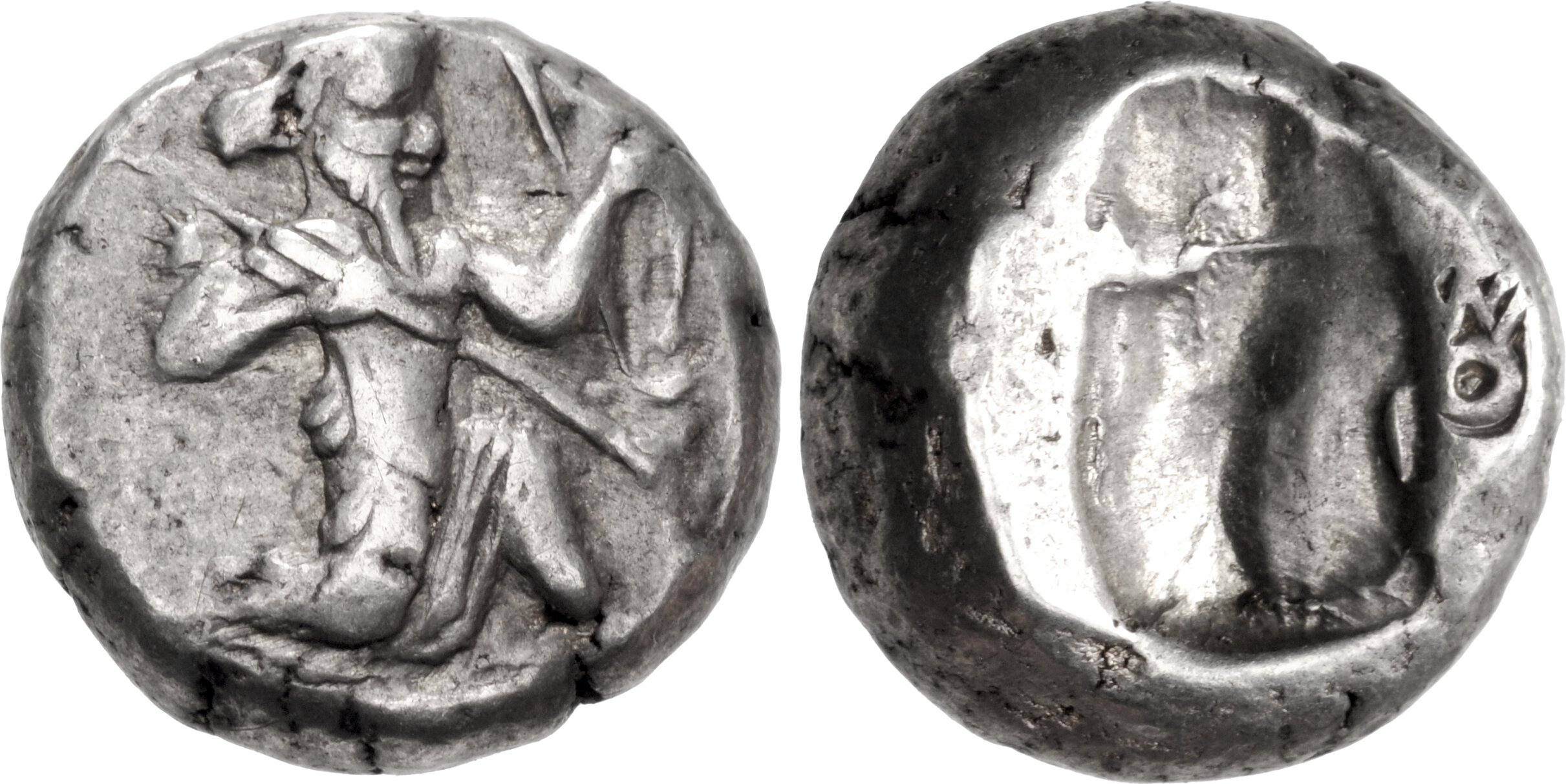S 2068 - Sardis (Xerxes - Darius II), silver, sigloi (Group IIIb) (480-425 BCE) Alram
From SILVER
480 BCE - 425 BCE Silver 1,610 kg
Description
| ObverseInscription or printing placed on the obverse.: | Persian king or hero, wearing kidaris and kandys, quiver over shoulder, in kneeling-running stance right, holding spear and bow |
| ReverseInscription or printing placed on the reverse.: | Incuse punch |
Mint and issuing power
| MintIdentifies the place of manufacture or issue of a numismatic object.: | Sardis | Ancient regionAncient region.: | Lydia | Modern countryModern country: Turkey | AuthorityIdentifies the issuing power. The authority can be "pretended" when the name or the portrait of X is on the coin but he/she was not the issuing power. It can also be "uncertain" when there is no mention of X on the coin but he/she was the issuing power according to the historical sources: | Artaxerxes I, Darius II, Persian Empire, Xerxes I |
Chronology
| FromIdentifies the initial date in a range assigned in a numismatic context. | 480 BCE | toIdentifies the final date in a range assigned in a numismatic context.. | 425 BCE | PeriodTime period of the numismatic object.: Classical 480-323 BC |
Physical description
| MetalThe physical material (usually metal) from which an object is made.: | Silver |
Median weightMedian of the weights of numismatic objects (in grams). in grams | 5.50 | DenominationTerm indicating the value of a numismatic object. Examples: tetradrachm, chalkous, denarius.: | siglos |
StandardStandard.: | Persian |
Image

S2068 Sardis sigloi Group IIIb.jpg [1]
References
| Die study referencePublication of the study: | Alram 19931Alram 1993 | ||
| Coin series referenceReference to coin series study: | |||
Obverse dies distribution
| FrequencyFrequency of specimen in distribution. ᵖ | Number of obversesNumber of obverse dies. ᵖ (o) | % (o) | Number of coinsNumber of coins. (n) | % (n) | Die nameName(s) of the die(s). |
| 1 | 2 | 18.18 | 2 | 6.67 | 5A, 5B |
| 2 | 3 | 27.27 | 6 | 20 | 1C, 1D, 4 |
| 3 | 4 | 36.36 | 12 | 40 | 1A, 1B, 2A, 2B |
| 4 | 1 | 9.09 | 4 | 13.33 | 2C |
| 6 | 1 | 9.09 | 6 | 20 | 3 |
| Total | 11 of 11 | 99.99 | 30 of 30 | 100 |
Reverse dies distribution
no distribution is available
Quantification
| Number of obversesNumber of obverse dies. ᵖ (o) | 11 | Number of singletons (o1)The number of singleton coins. ᵖ | 2 |
| Number of reverse diesNumber of reverse dies. (r) | Number of coinsNumber of coins. (n) | 30 | |
| Coins per obverse dieNumber of coins per obverse die. (n/o) | 2.73 | Coins per reverse dieNumber of coins per reverse die. (n/r) | |
| Reverse per obverse ratioRatio of obverse dies divided by reverse dies. (r/o) | Percentage of singletons (o1)number of coins (n) divided by the number of singletons (o1) ᵖ | 18.18 % | |
| Original number of dies (O) (Carter 1983 formula)The estimation of the number of coins according to Carter 1983 ᵖ | 14.64 | Coins struck if 20,000 as average productivity per dieCoins made if the average productivity for obverses (according to Carter) is 20,000. ᵖ | 292,800 |
| Original number of dies (O) (Esty 2011 formula)The estimation of the number of coins according to the singleton formula in Esty 2011 ᵖ (O) | 17.37 | Survival rate if 20,000 as average productivity per dieSurvival rate if average productivity is 20,000. ᵖ | 0.00010 |
| Coverage (o = % of O) (Esty 1984 formula)Esty 1984 - coverage (% of O) ᵖ (o = % of O) | 93.33% | Die productivity if survival rate 1/2,000Average productivity if survival rate is 1/2,000. ᵖ | 4,098.36 |
| Weight of silver (in kg) if 20,000 coins per die (O = Carter formula)Carter 1983 * Median weight * 20000 (*10 if gold or electrum) ᵖ | 1,610 kg <br /> 1,610 kg | Die productivity if survival rate 1/5,000Average productivity if survival rate is 1/5,000. ᵖ | 10,245.9 |
Remarks
Most likely one single workstation This die-study is a skeleton die-study from one single hoard (rich of 1491 sigloi)
References
- ^ Alram, Michael (1993), "Dareikos und siglos : Ein neuer schatzfund achaimenidischer sigloi aus kleinasien", Res Orientales, 5 (Rika Gyselen [ed.], Circulation des monnaies, des marchandises et des biens), p. 23-53.